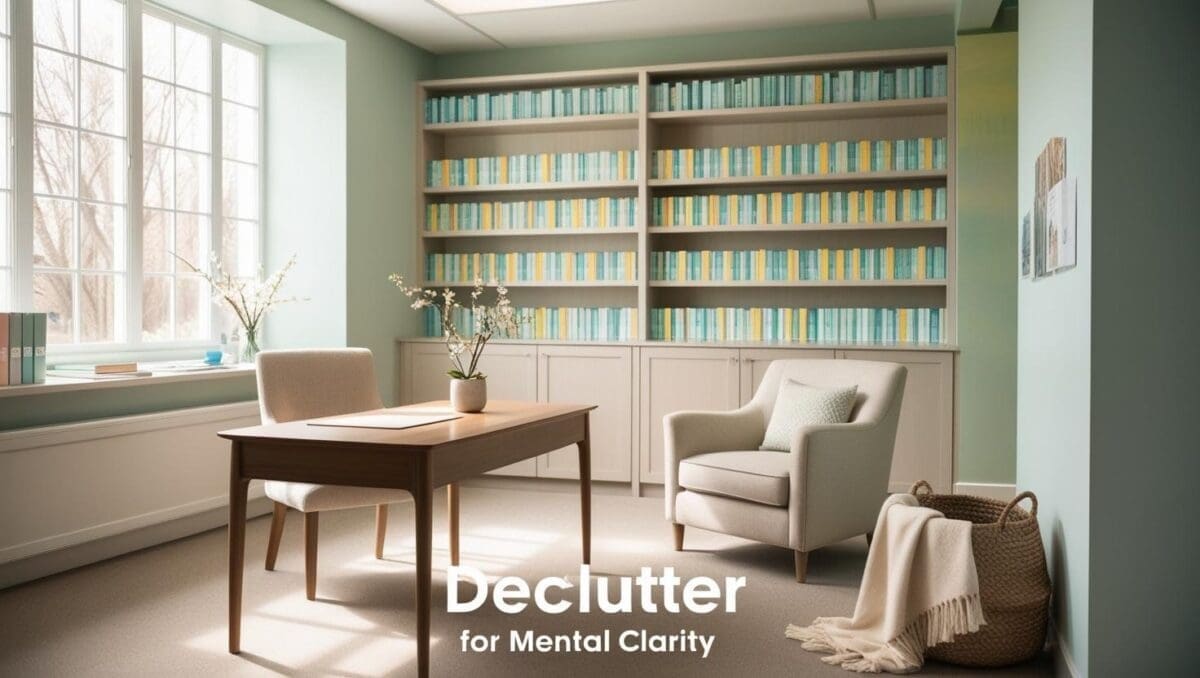Finding the Balance Between Minimalism and Warmth
Minimalist therapy office decor is often associated with clean lines, neutral colors, and clutter-free spaces—but minimalism doesn’t have to feel cold or impersonal. A well-designed minimalist therapy office can be both sleek and cozy, creating a space that fosters comfort, emotional warmth, and relaxation for clients.
By layering textures, choosing soft lighting, and incorporating subtle decor elements, you can create a minimalist yet inviting space that feels professional, calm, and emotionally supportive.
In this guide I will walk you through how to add warmth to a minimalist therapy office without losing the clean and simple aesthetic.
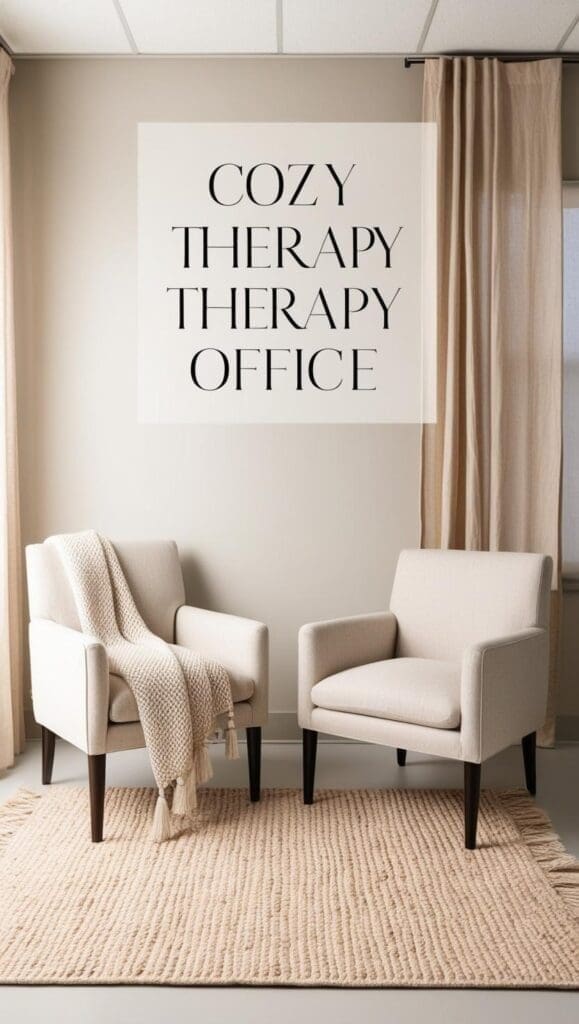
1. The Power of Textures: Creating Warmth Without Clutter
Minimalism thrives on simplicity, but without softness, it can sometimes feel cold or sterile—especially in a therapy setting. The secret to making a minimalist therapy office feel cozy lies in intentional layering of textures that invite comfort and connection without adding visual noise.
Why texture matters in therapy spaces:
Soft materials don’t just feel good—they also signal safety, softness, and approachability to your clients. Textures ground us in the present moment, helping regulate the nervous system through subtle sensory input.
Best Cozy Textures for a Minimalist Therapy Office:
✔ Linen Curtains
Lightweight and naturally wrinkled, linen drapes gently filter light while softening the room’s edges—adding movement and calm without drawing attention.
✔ Woven Throw Blankets
Folded neatly over an armchair or couch, a simple knit or waffle-textured blanket offers warmth and care, especially for clients who benefit from grounding objects.
✔ Plush or Low-Pile Rugs
A neutral-toned rug under your seating area softens acoustics, adds comfort underfoot, and visually defines the client space—without disrupting minimalism.
✔ Velvet or Bouclé Upholstery
Consider adding one piece—like a client chair or pillow—in soft, touchable fabric. These materials feel luxurious and soothing, elevating the room’s emotional tone.
💡 Design tip: Choose just 1–2 of these textures and repeat them subtly across the room to create warmth without clutter.
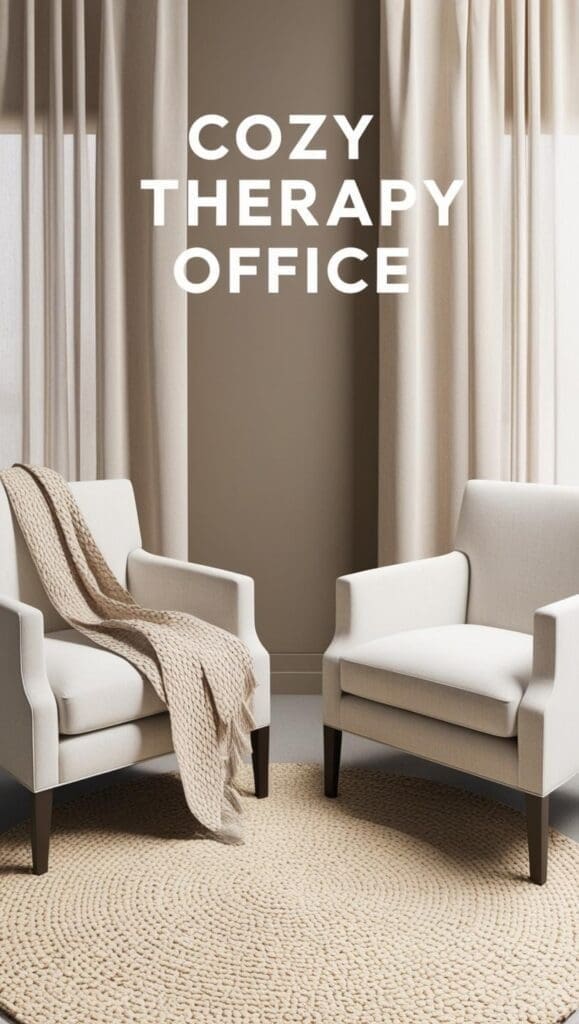
2. Warm Minimalist Color Palettes: Choosing Inviting Tones
Color isn’t just visual—it’s emotional. In therapy offices, the palette you choose can help shape how safe, open, and supported your clients feel the moment they walk through the door. While traditional minimalism leans heavily on crisp whites and cool greys, warm-toned neutrals offer the same simplicity with an added layer of softness and emotional comfort.
Why color matters in therapy spaces:
According to color psychology, soft, earthy hues help regulate the nervous system and evoke feelings of calm, warmth, and trust—all essential for therapeutic connection.
Best Cozy Minimalist Color Palettes for Therapy Offices:
✔ Warm Beiges & Soft Taupes
These colors offer a neutral base that feels grounded and comforting, without veering into sterile or clinical.
✔ Dusty Blush & Muted Pinks
Just a hint of pink brings subtle warmth and softness, adding a gentle, welcoming tone—especially effective in feminine or trauma-informed spaces.
✔ Sage Green & Earthy Tones
Inspired by nature, these shades promote emotional stability, mindfulness, and a sense of inner peace.
✔ Soft Caramel & Light Wood Tones
Incorporate these through flooring, furniture, or decor accents to bring organic warmth that complements minimalist design.
🎨 Design tip: Limit your palette to 2–3 tones and repeat them throughout your space (walls, textiles, furniture) to maintain cohesion without visual noise.
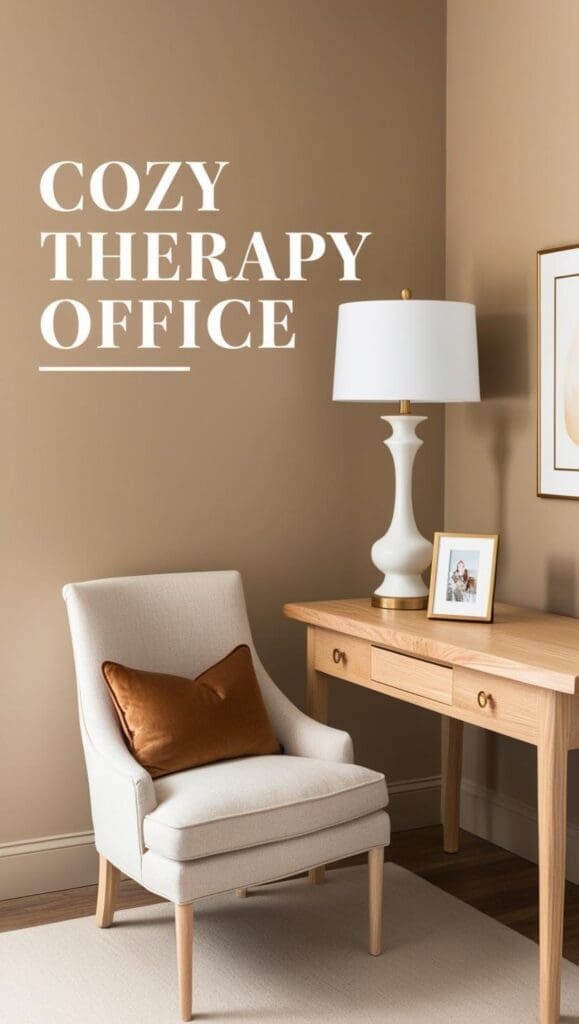
3. Soft, Warm Lighting for a Cozy Atmosphere
Lighting can make or break the emotional tone of a therapy space. In a minimalist office, where every design element is intentional, the right lighting helps shift the environment from sterile to serene—supporting regulation, trust, and focus.
Why lighting matters in therapy spaces:
Warm lighting soothes the nervous system, reduces visual overstimulation, and helps both clients and therapists feel more grounded during sessions.
Best Cozy Lighting Solutions for Minimalist Therapy Offices:
✔ Cordless, Rechargeable Lamps
A therapist favorite for a reason—these eliminate cords and clutter while offering a warm glow that can be moved anywhere you need it (perfect for small or shared offices).
✔ Wall Sconces with Warm LED Bulbs
Wall-mounted lights provide a gentle wash of ambient light without taking up floor or table space—ideal for maintaining a clean, uncluttered aesthetic.
✔ Soft Glow Table Lamps
Place one near the client’s seating area to create a calming focal point. Choose fabric or frosted glass shades to diffuse light softly.
✔ Dimmer Switches for Overhead Lighting
Gain control over brightness depending on the session type, time of day, or client needs. Dimming lights can ease transitions and support emotional regulation.
💡 Lighting tip: Stick to warm white bulbs (2700K–3000K) to maintain a cozy tone that feels therapeutic—not clinical.
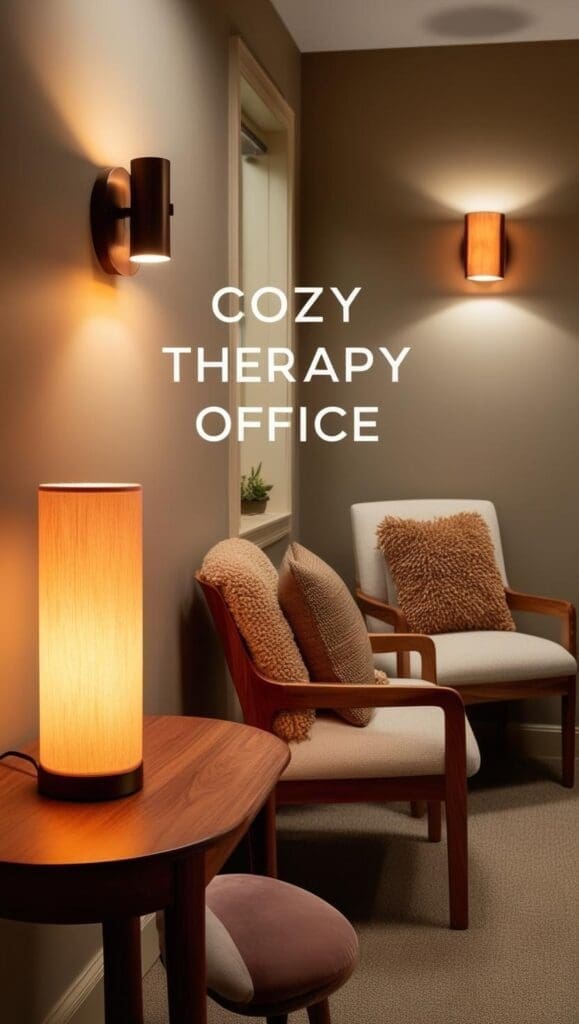
4. Minimalist Decor Accents That Feel Inviting
Minimalism doesn’t have to mean bare. In a therapy office, even the simplest space benefits from a few intentional accents that soften the environment and invite comfort. The key is to choose pieces that spark warmth and connection—without disrupting visual calm.
Why decor matters in therapy spaces:
Thoughtful, subtle decor can create emotional anchors for clients, signal care and intentionality, and help transform a blank room into a healing space.
Minimalist Decor Elements for a Warm Aesthetic:
✔ Framed Abstract or Nature-Inspired Art
Choose one or two large pieces with muted tones and gentle movement. Botanical line drawings, abstract landscapes, or calming watercolors offer visual interest without overstimulation.
✔ A Single, Statement Plant
Bring life into the space with one living element. A fiddle leaf fig, peace lily, or tabletop eucalyptus adds organic warmth and purifies the air—grounding the room through nature.
✔ Elegant Candles or Scent Diffusers
Scent is a powerful emotional cue. Use subtle, trauma-informed options like vanilla, sandalwood, or lavender to enhance calm without overpowering sensitive clients.
✔ A Beautifully Curated Bookshelf
Keep it minimalist but meaningful: a few neutral-colored therapy books, one framed photo, and a grounding object like a stone, sculpture, or hourglass. It becomes both a functional and emotional focal point.
🕯️ Styling tip: Keep surfaces mostly clear. In minimalist design, negative space is part of the decor—it lets the warmth of each chosen item breathe.
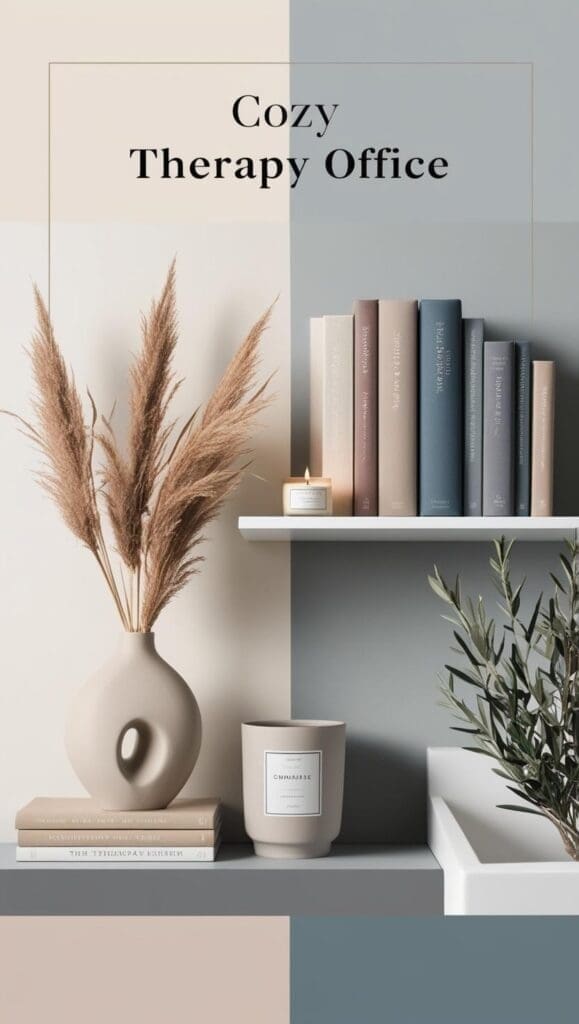
5. Comfortable Seating That Maintains a Minimalist Look
In therapy, how a client sits matters just as much as what is said. Seating should support emotional safety, physical comfort, and your design goals—all without overwhelming a minimalist space. The key is to choose cozy pieces with clean lines and intentional placement.
Why seating matters in minimalist therapy offices:
Seating helps set boundaries, encourage grounded posture, and establish the emotional tone of the session. Minimalist seating should feel soft and supportive—never stiff, oversized, or clinical.
Best Minimalist Seating Options for a Cozy Therapy Office:
✔ A Soft, Neutral Armchair
Upholstered in textured materials like linen, velvet, or bouclé, a well-designed armchair provides both structure and softness. Choose warm, neutral tones like oatmeal, mushroom, or sage to stay aligned with your color palette.
✔ A Loveseat Instead of Multiple Chairs
A small, cozy loveseat creates an intimate, safe-feeling space for individual clients or pairs—ideal for couples therapy or child–parent sessions. It removes visual clutter while promoting closeness.
✔ A Padded Bench with Hidden Storage
Multipurpose and clean-lined, a bench near the entry or beneath a window offers flexible seating plus concealed space for storing sensory tools, tissues, or grounding items.
✔ Accent Pillows in Warm, Muted Tones
A single lumbar or throw pillow can soften the formality of a structured chair. Stick to earthy hues—terracotta, slate blue, muted rose—and minimal patterns to keep the look cohesive.
🪑 Therapist insight: Choose seating that allows for grounded posture with back support and feet flat on the floor. Physical comfort directly supports emotional regulation in session.
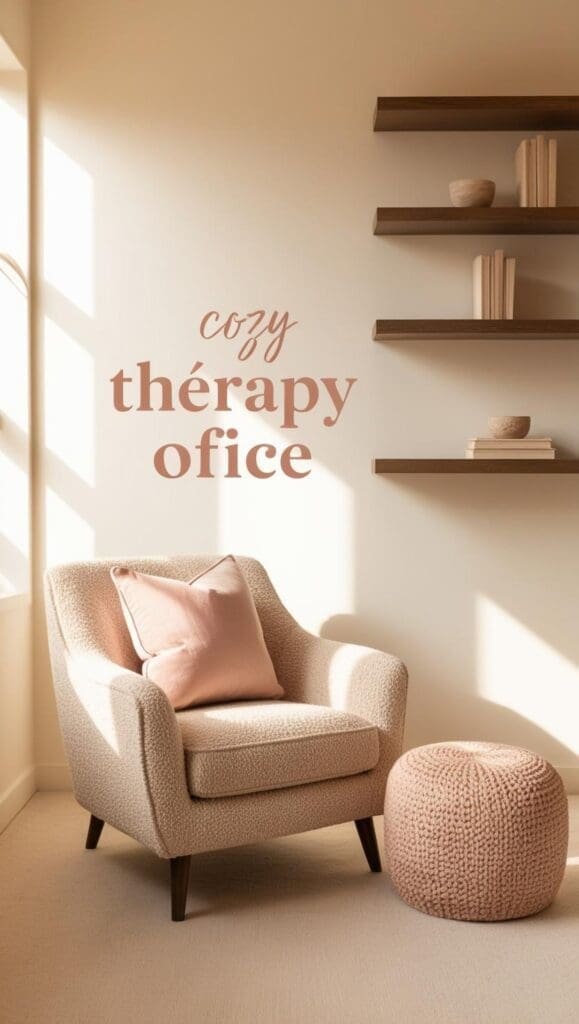
Cozy Minimalism in Therapy Office Design
Minimalism in therapy design isn’t about empty walls or sterile surfaces—it’s about intentional simplicity that supports emotional safety. When balanced with warmth, texture, and light, a minimalist therapy office becomes more than just a workspace—it becomes a grounding space where healing can begin.
By thoughtfully layering cozy elements like soft textiles, gentle lighting, and natural materials within a clean, uncluttered environment, you create a setting that soothes the nervous system, reduces overwhelm, and helps clients feel held without distraction.
A cozy minimalist office reflects your presence as a therapist: calm, clear, and compassionate.
Whether you’re designing a new space or refreshing your current one, remember: you don’t need more things—just more intention.
Want More Therapy Office Inspiration?
Here are more guides to help you create a space that supports your clients and your style:
No Wiring? No Problem – Use Cordless Lamps in Therapy Spaces
The Best Accent Armchairs for Your Therapy Office
How to Use Wallpaper for a Cozy Therapy Office
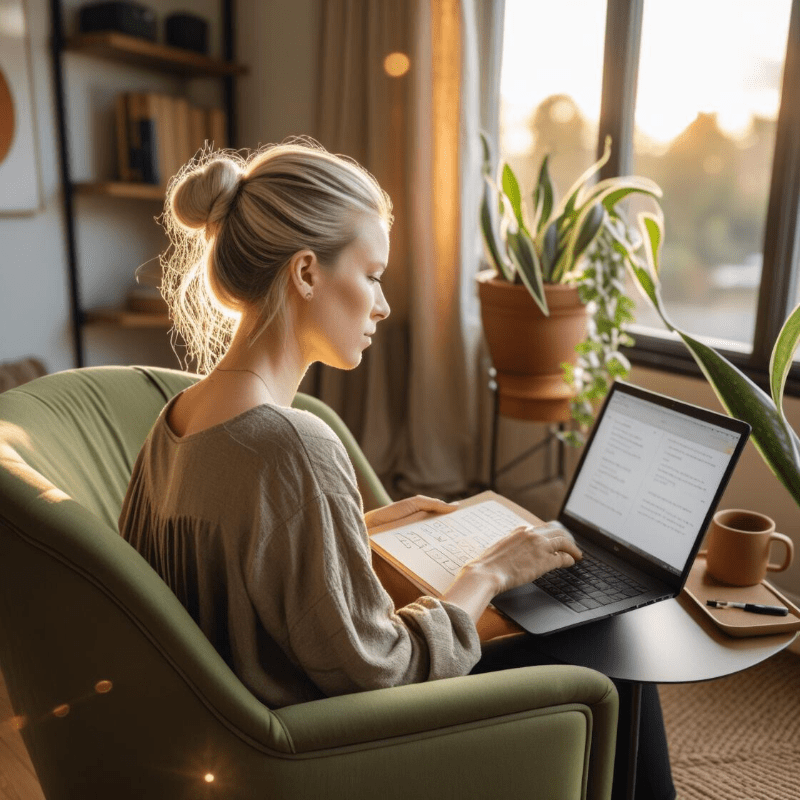
About the Author
Hi, I’m Eve, a former school counselor with a master’s degree in School Psychology and a passionate advocate for children and families navigating sensory challenges. As a mom of children with sensory sensitivities, I deeply understand the journey special-needs parents face, and I dedicate myself to researching and sharing practical solutions to help children thrive and feel comfortable in their bodies. My goal is also to empower counselors, therapists, and psychologists with creative strategies and supportive resources to enrich their everyday practice. When I’m not writing or exploring new therapeutic approaches, you’ll find me spending quality time with my family and continually seeking inspiration from everyday moments.

